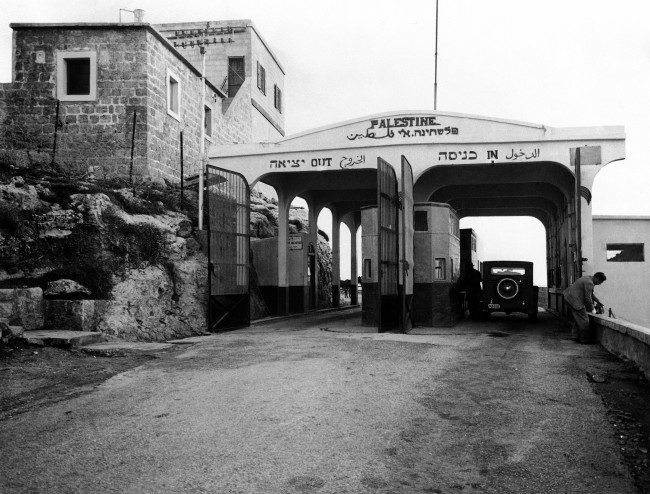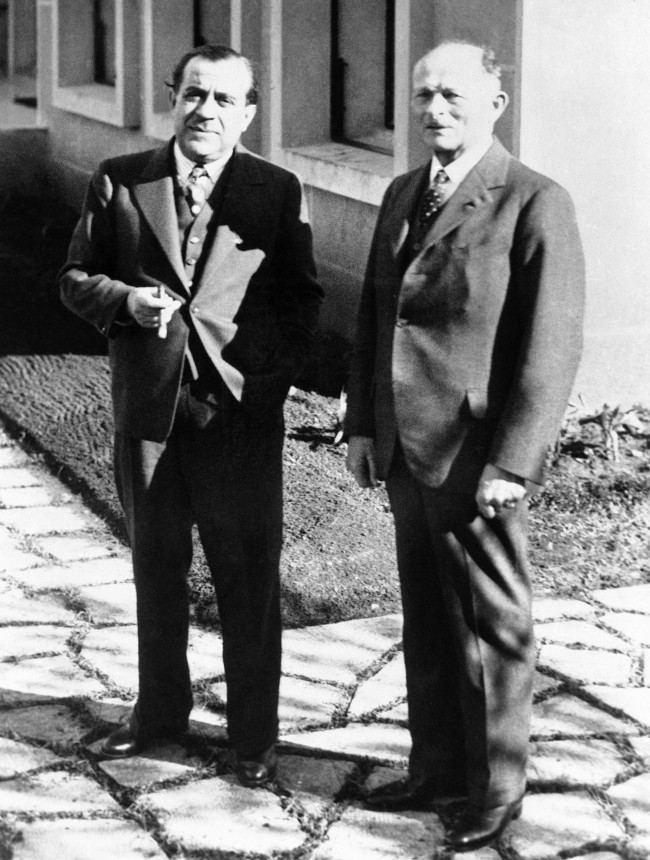Rare And Wonderful Photographs Of Syria Before 1940

Turkish soldiers at military review at Damascus, Syria in an undated photo. (AP Photo)
Date: 01/01/1914

Some 10,000 of the 48,000 Palestine Arab Refugees who have settled in and around Damascus, Syria, staged a demonstration in Damascus, last week in April 1929 to express their gratitude to the Syrian Army for the recent Syria-Israel border clashes. They asked to be accepted as volunteers for the Syrian fighting forces so that they night fight back at Israel, upon which country they blame their present unhappy condition as refugees. Photo shows: An elderly lady addresses a great crowd of Palestine Arabs in the court-yard of the Army General Headquarters in Damascus. Her speech was among others heard there by Syrian Officers. (AP Photo)
Date: 01/04/1929

U.S. President Herbert Hoover and his wife, Lou Henry Hoover, pause on a bridge as they take a stroll at Rapidan Camp, their weekend retreat in Syria, Va., on Aug. 2, 1930. (AP Photo)

This is a typical scene in the ancient northern Syrian town of Talbeseh, in 1936. (AP Photo)

Life in ancient Talbeseh, a Syrian village built entirely of mud and wood because of the scarcity of stone, is shown May 22, 1936. (AP Photo)

With a rifle at hand to stave off further attacks, this group of Jewish colonists, aided by Arab villagers, String barded wire in the 50 mile, tegarts wall, on the Palestine-Syria border on July 20, 1938 after bands of Marauding Arabs damaged the fence and engaged police in rifle fire. Arab bands and colonists have engaged with fatal result in clashes throughout July. (AP Photo)
Date: 20/07/1938

The gateway from Syria into Palestine, in 1938. Owing to the secret entry of thousands of Arab Rebels from Syria and the Lebanon into the Holy land, strict watch was kept by the French and British police at the frontier. (AP Photo)

France and Turkey concluded a military agreement over the Sanjak of Alexandretta, territory between Asiatic Turkey and Syria, to ensure internal security. Agreement was on parity basis and 2,500 French, non-Syrian troops, and 2,500 Turkish troops are being kept available now. Happy Turkish crowds applauding the march past of the Turkish troops as they entered the Sanjak of Alexandretta, Turkey on July 1, 1938. Streets and balconies are be flagged with the Turkish red flag with white crescent which they had not seen in the territory for nearly 20 years. (AP Photo)
Date: 01/07/1938

In Syria and other arid countries of the Middle East, immemorial oxen are used to raise water from the native rivers and lakes for use in irrigation on August 23, 1938 in Syria. Same crude paraphernalia as in biblical times. (AP Photo)

Caravans of camels conveying salt from the rivers and seas of ancient Syria to a ‘salt mountain’ near Aleppo, Syria on August 23, 1938, one of the oldest cities in the world. (AP Photo)


American Jewish colonists in Palestine completing the so called Tegart fence, on Aug. 23, 1938, which cost 500,000 dollars to build. It is 75 kilometres long, on the Palestine-Syria border, was suggested by Sir Charles Tegart, part of the British scheme to stamp out the Palestine disorders. (AP Photo)

An Arab stands beside a section of Tegart’s Iron wallî in Israel in 1938, erected by Sir Charles Tegart to keep marauding Arabs out of Palestine. The fence, three strains of barbed wire on angular iron supports. Stretches for 60 miles on the Syria-Lebanon borders and cost $ 500,000. (AP Photo/James Mills )

Fakhri Nashashibi, member of the Arab National Defence Committee is challenging the leadership of the ex-mufti of Jerusalem, Haj Amin Effendi Al Husseini, in exile in Syria. Nashashibi, who comes from one of the most distinguished Arab families in Palestine, says the ex-mufti is no prophet but a self-seeking politician, who is running Palestine by his campaign of terror. Fakhri Nashashibi, in Jerusalem, on Nov. 24, 1938. (AP Photo)

Fakhri Nashashibi, member of the Arab National Defence Committee is challenging the leadership of the ex-mufti of Jerusalem, Haj Amin Effendi Al Husseini, in exile in Syria. Nashashibi, who comes from one of the most distinguished Arab families in Palestine, says the ex-mufti is no prophet but a self-seeking politician, who is running Palestine by his campaign of terror. Fakhri Nashashibi stands between two of his chief supporters, tribal heads from the Hebron District, in Jerusalem, on Nov. 24, 1938. (AP Photo)

A view of Damascus, Syria, oldest city in the world, with towering hills in background, in December 1938. (AP Photo)

The six standing columns are the remains of the Temple of Jupiter, which in its day was considered one of the wonders of the world, near the town of Baalbek, in Syria, in Dec. 1938.. (AP Photo)

Skilled Syrian crafts man working by the light of the sun in an ancient shop in Damascus in December 1938. (AP Photo)

A scene in the famous Mosque of Omey-yade, Damascus, Syria, in December 1938. This famous Mohammedan Shrine ranks with the Mosques at Mecca, Medina and Jerusalem. It also-commemorates the beheading of John the Baptist whose head is supposed to repose in the premises. (AP Photo)

Mount Acora, a famous range in Northwest Syria, near the famous biblical town of Antioch on Dec. 2, 1938, where St. Paul preached the Gospel. Note that the curious snow formation on the pinnacle of the mountain forms the outline of a manÂs face, to which the untutored natives attribute mysterious powers. (AP Photo)

A scene in the Lebanon Mountains, north of Palestine, famous for their stately cedar trees. The picture shows a Christmas-card scene in the region north of Damascus, Syria, on Dec. 2, 1938. (AP Photo)

The non-ratification of the Franco-Syrian treaty has resulted in the calling of a general strike, accompanied by demonstrations, against this policy in Damascus. The demonstrators are demanding the dissolution of the Syrian government in spite of the investigation into the whole question promised by the new French high commissioner in Syria. Dr. Charbandar, the leader of the Opposition in the Syrian chamber of deputies, addresses the crowd which had gathered round his house from one of the windows in Syria, on Jan. 23, 1939. (AP Photo)

The Former French War Minister General Maxime Weygand, right, snapped with Emile Edde, the President of the Republic of Lebanon, on Feb. 15, 1939, during the generalÂs present visit to Syria. (AP Photo)

Shahpur Mohammed Riza, Crown Prince of Iran, has now arrived in Cairo for his wedding to Princess Fawzia, sister of King Farouk of Egypt. He boarded the Egyptian Royal Yacht Mahroussa at Beirut, Syria, and with an Escort of Egyptian naval craft, left for Alexandria. Shahpur Mohammed Riza, Crown Prince of Iran, left, acknowledging the welcome of the crowd when he passed through Damascus, on his journey to Cairo on March 5, 1939. With the Crown Prince is the Syrian Minister of Finance and War. (AP Photo)

The Former French War Minister General Maxime Weygand, right, snapped with Emile Edde, the President of the Republic of Lebanon, on Feb. 15, 1939, during the generalÂs present visit to Syria. (AP Photo)

The French military authorities have taken over control of the city of Damascus, the capital of French Syria, following the disorders resulting from the General strike and the resignation of the government. Barbed wire barricades and military guards in the Place Des Martyrs, the principal square of Damascus on March 29, 1939, after the city had been placed under military control. (AP Photo)

Thousands of Armenian refugees have poured into Syria from the Sanjak of Alexandretta as the Turkish troops occupied the last border strip of the area ceded to them by the French. With them also were several hundred Turkish opponents of the present government in Ankara. Some of the refugees actually set fire to their homes rather than let them fall into Turkish Hands. Armenian refugees in a temporary encampment in Syria after their flight, on August 2, 1939. (AP Photo)
More Galleries
Posted: 14th, October 2014 | In: In Pictures, Reviews Comment (1) | TrackBack | Permalink








